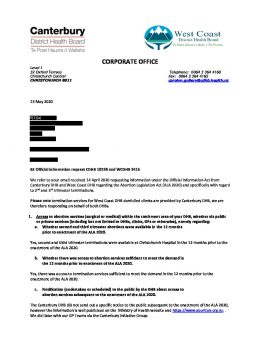RE Official information request CDHB 10298 and WCDHB 9416
We refer to your email received 14 April 2020 requesting information under the Official Information Act from Canterbury DHB and West Coast DHB regarding the Abortion Legislation Act (ALA 2020) and specifically with regard to 2nd and 3rd trimester terminations.
Please note termination services for West Coast DHB domiciled clients are provided by Canterbury DHB, we are therefore responding on behalf of both DHBs.
1. Access to abortion services (surgical or medical) within the catchment area of your DHB, whether via public or private services (including but not limited to DHBs, clinics, GPs or otherwise), namely regarding:
a. Whether second and third trimester abortions were available in the 12 months prior to enactment of the ALA 2020.
b. Whether there was access to abortion services sufficient to meet the demand in the 12 months prior to enactment of the ALA 2020.
c. Notification (undertaken or scheduled) to the public by the DHB about access to abortion services subsequent to the enactment of the ALA 2020.
d. Whether the access to abortion services is projected to be sufficient to meet the demand for abortion services in the 12 months subsequent to the enactment of the ALA 2020.
2. The identity of which entities are providing abortion services (surgical or medical) within the catchment area of the DHB, whether via public or private services (including but not limited to DHBs, clinics, GPs or otherwise).
3. Provision of abortion services (surgical or medical) within the catchment area of your DHB, namely:
a. The number of second trimester abortions carried out in the 12 months prior to enactment of the ALA 2020 and whether such were medical or surgical abortions.
b. The number of third trimesters abortions carried out in the 12 months prior to enactment of the ALA 2020 and whether such were medical or surgical abortions.
c. The gestation (in weeks) of the pregnancy.
d. The legal grounds for the carrying out of the abortion.
e. The number of operating certifying consultants available to provide the service.
f. The age of operating certifying consultants available to provide the service. This request may be answered by reference to the age range that a consultant falls within (eg 30s, 40s, 50s, 60s years of age).
g. Where any second or third trimester abortion was not carried out, whether the DHB declined to provide such services and whether that was as a result of the unavailability of personnel.
h. And if so, where were the women transferred to or referred to, whether in New Zealand or Australia or elsewhere.
i. Whether the abortions carried out in the 12 months prior to enactment of the ALA 2020 were undertaken in conjunction with a multi-disciplinary medical team.
j. Any projected number of second trimester abortions and third trimester abortions to be carried out in the 12 months and 24 months subsequent to the enactment of the ALA 2020.
4. The identity of which entities provide the resourcing of abortion services (surgical or medical) within the catchment area of your DHB, whether via public or private services, including but not limited to, DHBs, clinics, GPs or otherwise).
5. Human resourcing of abortion services (surgical or medical) within the catchment area of your DHB, namely regarding certifying consultants, operating doctors, theatre staff, nurses, support staff, namely:
a. Whether the DHB had sufficient staff (whether employees, contractors or otherwise) to meet the demand in the 12 months prior to enactment of the ALA 2020.
b. Whether in the 12 months prior to enactment of the ALA 2020 the DHB seconded staff or personnel to or from other providers of abortion services to meet that demand.
c. Whether the DHB will have sufficient staff (whether employees, contractors or otherwise) to meet any projected demand in the 12 months and 24 months subsequent to enactment of the ALA 2020.
6. The identity of which entities (whether Ministries or Departments or otherwise) are funding abortion services (surgical or medical) within the catchment area of your DHB, whether via public or private services (including but not limited to DHBs, clinics, GPs or otherwise).
7. Funding abortion services (surgical or medical) within the catchment area of your DHB, namely:
a. Whether second and third trimester abortions were funded by the DHB in the 12 months prior to enactment of the ALA 2020.
b. Whether second and third trimester abortions will be funded by the DHB in the 12 months subsequent to enactment of the ALA 2020.
8. Since 1 December 2017 any Ministry of Health advice (or by any other Ministries or Departments or otherwise) to your DHB regarding access to, or provision of or funding of surgical or medical abortion services.
9. Since 1 December 2017 any advice by the DHB to the Minister of Health regarding access to, or provision of or funding of surgical or medical abortion services throughout New Zealand and the particular area for which your DHB is responsible.
10. The DHB’s policies, stance or advice regarding conscience objections regarding abortion services, whether by any medical health practitioner, employee, contractor or otherwise.
11. Since 1 December 2017 any DHB review of its policies, stance or advice regarding conscience objections regarding abortion services, whether by any medical health practitioner, employee, contractor or otherwise.
12. Since 1 December 2017 any DHB review of or consideration of steps taken or steps to be taken to manage, respond to or implement the enactment of the ALA 2020, namely regarding:
a. The new conscience objection provisions.
b. The new wider lawful access to abortion services.
c. Providing abortion services in response to the new wider lawful access.
d. Human resourcing abortion services in response to the new wider lawful access.
e. Funding abortion services in response to the new wider lawful access.

